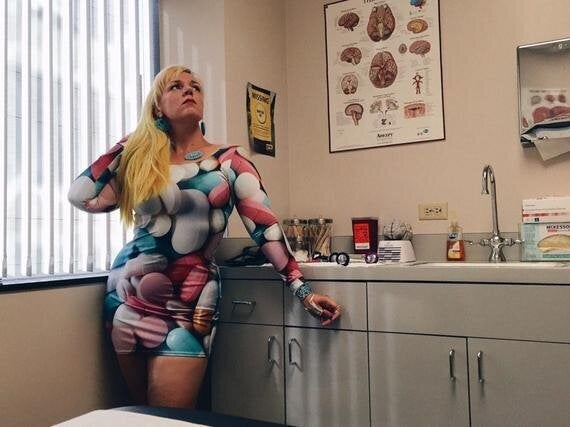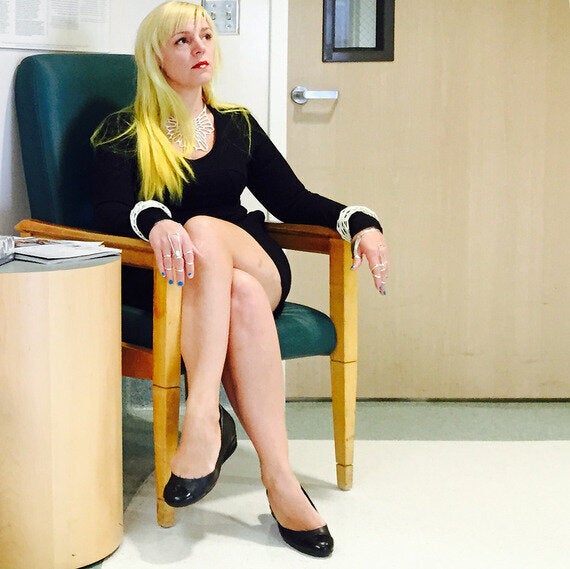Karolyn Gehrig, like myself, has Ehlers-Danlos Syndrome. It's a genetic condition that's caused by a fault in the connective tissue - the stuff that basically holds us together. While the condition has various types, there are some symptoms that are common across the Ehlers-Danlos spectrum. It's usually incredibly painful, exhausting, and impacts every part of the body from the joints to the organs. And there's no cure. Many of us spend endless time in and out of hospital.
Last April Karolyn tweeted some selfies. Her and everyone else, right? But her photos are very different to the usual backgrounds of partying and having fun with friends. She's framed by treatment rooms, face masks and the wires attached to her body. She's sporting her silver ring splints (worn to reduce joint dislocations) and uses her walking stick as a prop. My favourite is her skin-tight dress that's covered in pills. She tags these selfies as #hospitalglam, and they certainly are.

Follow the #hospitalglam Tumblr for more images.
Since Karolyn's tweets many others have joined in; posting selfies in waiting rooms, after operations or of a high heel peeking out of a hospital gown.
So why has this resonated for those of us with disabilities?
Having a chronic illness can be scary, and all-consuming. You can feel like you've lost control when your body won't do what you ask. Decisions are constantly taken out of your hands - about your mobility, ability to work, social life and relationships. And at the centre of that loss is the medical world. Most people don't get to choose their consultants, their treatment plan or their medication. Even if you have a great doctor you are constrained by budgets, research, and availability of treatments.
In the midst of all this other decisions get wrested from you too - your hair, your clothes and your accessories. Funky handbags are swapped for practical ones that stay put when you're using a walking stick or crutches. A favourite necklace has to be removed because it tangles with wires. You pick new clothes based not on the designer, or because you love the colour, but by comfort so as to reduce chronic pain flare ups. Smart shirts get thrown out because buttons were designed by the devil, or t-shirts discarded because you can't lift your arms up. I was never a fashionista, but I've lost count of the items I've thrown out that simply no longer fit into my world.
And if we do dare to put on make-up and nice clothes and do our hair we are often misjudged - "she can't be that unwell", we hear, sometimes silently, sometimes not. This feeling creeps into the NHS too. I know of many people who won't wear make-up when discussing pain relief with a doctor because they think they won't be taken as seriously.
The Department of Work and Pensions openly judges appearance during benefit assessments. They ask assessors to make notes on "the claimant's appearance, manner, hearing ability, walking ability," and they will frequently use this 'informal observations' section to make comments on clothing, make-up and hair. A comment on my own form actually stated: "Wearing brightly coloured clothes which shows no outward sign of depression". I was wearing baggy yoga clothing because anything tight was painful, and the assessor made a totally inaccurate correlation between the colour of my t-shirt and my health.
Similarly, I often wear my hair in a ponytail because it reduces my neck pain. On my medical form that hairstyle seemed to equate to an ability to lift my arms, but I wasn't asked if someone else had done it, which they had. Due to notes like these made by the assessor, my Disability Living Allowance claim was turned down twice. The two tribunal cases that followed were horrific. I was cross-examined and treated like a criminal.
These experiences have enormous ramifications for so many people trying their best to navigate the system. The wait for a tribunal can last between six months to a year, and causes immense stress.
When you have an invisible condition, you can face an additional level of scrutiny and are often having to work much harder to prove how ill you feel. So it's not surprising that sometimes I feel like I'm losing myself. Already, my world centres on ill health - doctors' appointments, hospital stays and physiotherapy. But I'm still a person under the hospital gown. I still like my nails to be brightly coloured even when my hands are covered in bruises from a cannula, or welts from a blood pressure machine.

#hospitalglam is about taking back that control and saying you can wear what you want to, and it doesn't represent how you feel. While disabled people are already there, society and the medical establishment lag behind - often still expecting one specific look from a person deemed chronically ill.
Make-up and smart clothes shouldn't clash with anyone's idea of disability - so come on world, catch up.
Originally published at Mumsnet.com and my blog The Chronic Chronicles.